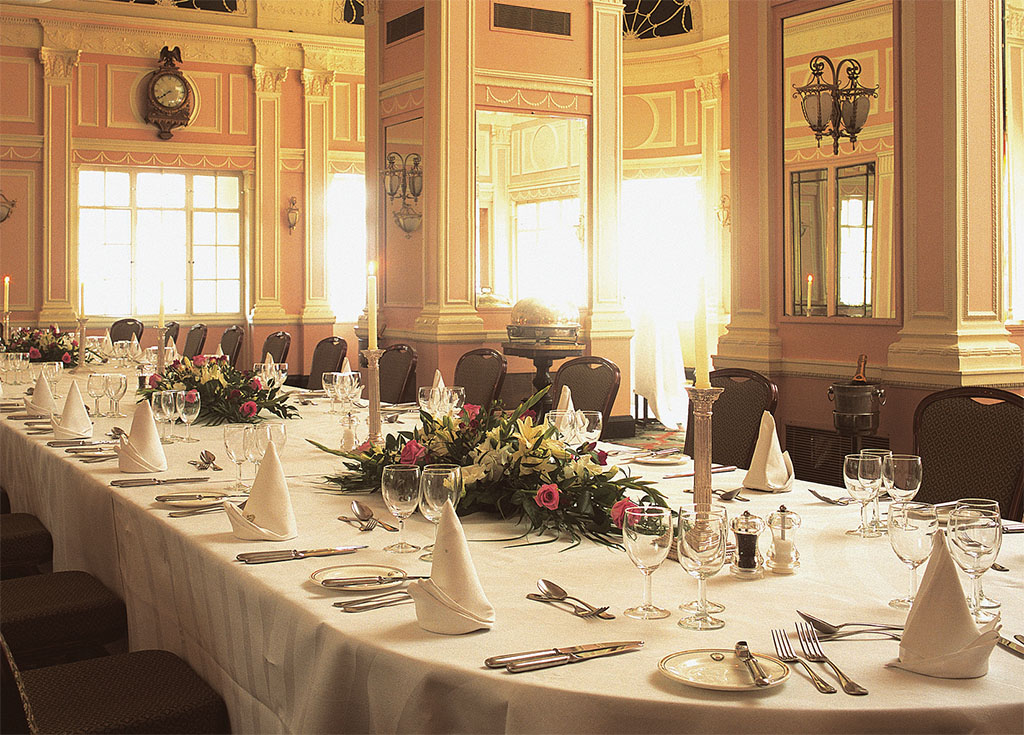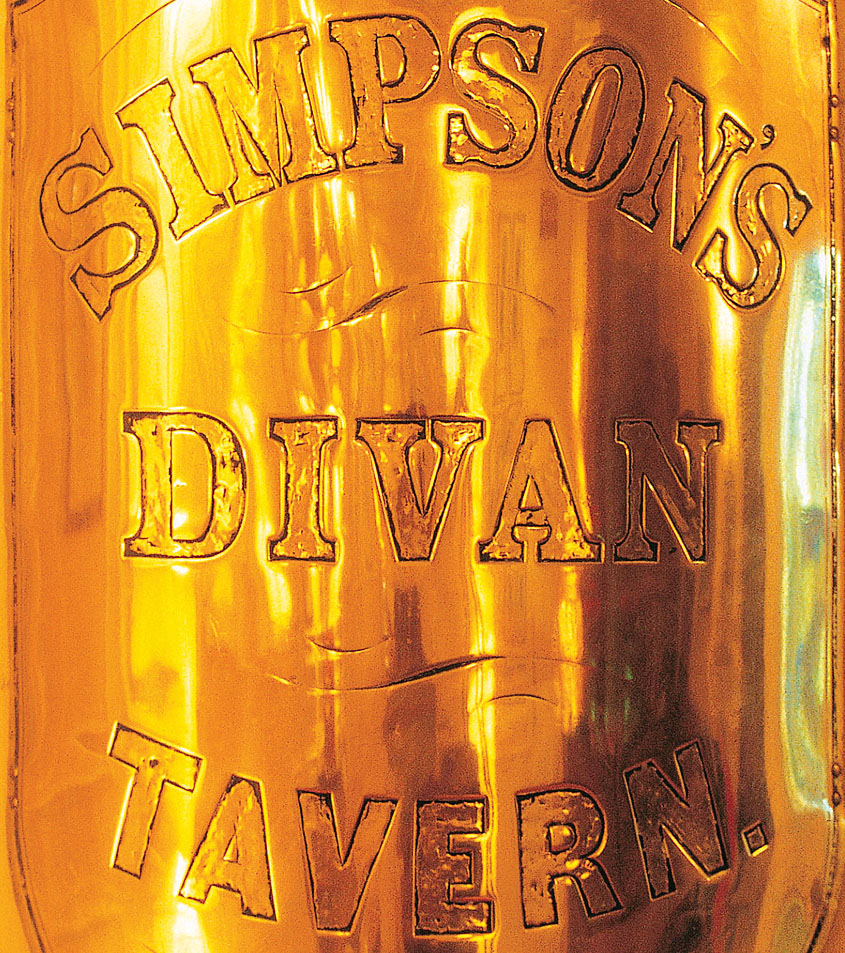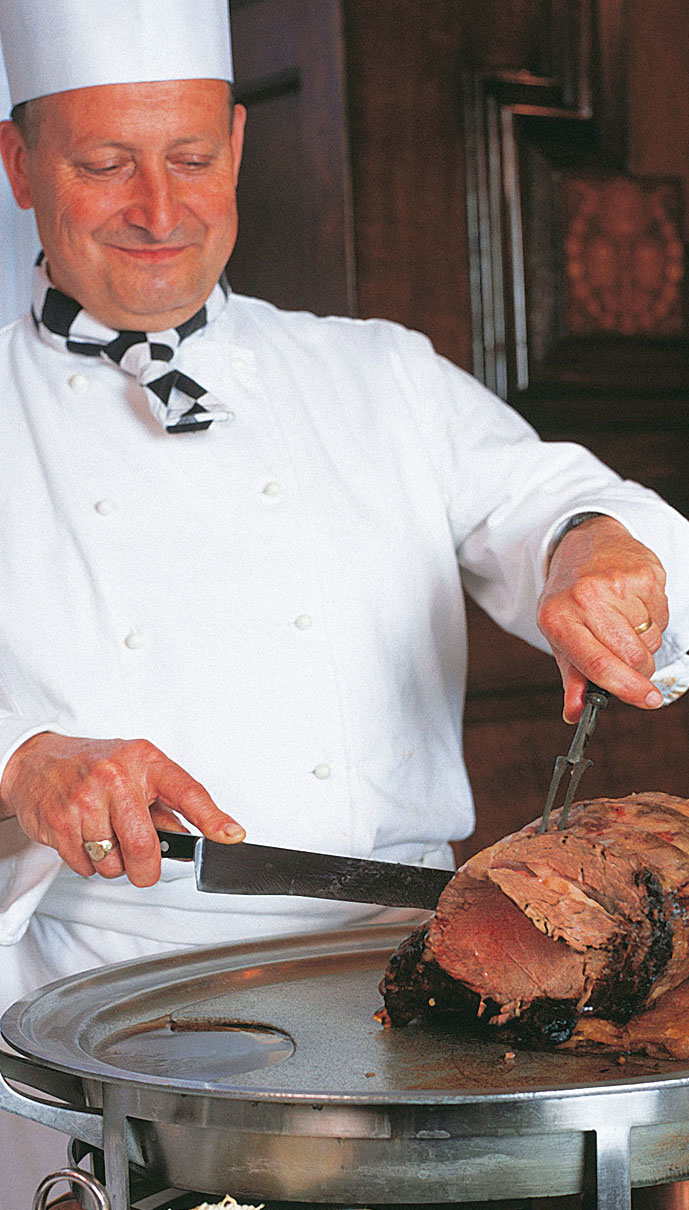
Simpson’s-in-the-Strand
Editor’s note: For two decades now, London has enjoyed one of the most vital and diverse restaurant scenes in the world. Among the thousands of culinary establishments across the metropolis, diners can enjoy food traditions and cooking methods from every corner of the globe, from East Africa to South America, as well as the popular regional cuisines of Europe and Asia. As in every major world-class city, London restaurants come and go, rising and falling in popularity as eating fashions (and temperamental chefs) ebb and flow. Some things, though, never change.
Amidst the ubiquitous pasta palaces and curry clubs, there flourish a handful of establishments that have remained seemingly timeless, where Londoners and visitors alike dine on old-fashioned British fare. With this issue we begin a series of visits to some of the historic London restaurants. Let’s dine first at Simpson’s-in-the-Strand, where the roast beef of old England is king of the kitchen as it has been for generations.
[caption id="HistoricLondonDining_img1" align="alignright" width="1024"]

Simpson’s-in-the-Strand
[caption id="HistoricLondonDining_img2" align="aligncenter" width="870"]

Simpson’s-in-the-Strand
[caption id="HistoricLondonDining_img3" align="alignright" width="845"]

Simpson’s-in-the-Strand
A RECENT ITEM IN A LONDON newspaper stirred my interest with mention of a course in meat carving at Simpson’s-in-the-Strand restaurant. Perhaps it was time to revisit the establishment that has been such a fixture on the busy Strand for almost two centuries and seems to still be a favorite with tourists as well as the English.
Simpson’s dates back to 1848 when coffeehouse owner Samuel Reiss teamed up with his headwaiter John Simpson to expand the business. Reiss, owner of the Grand Cigar Divan since 1828, and Simpson enlarged the building, expanded it as a restaurant and renamed it Simpson’s Grand Divan Tavern. Reiss’ Grand Cigar Divan had been a popular chess spot in London, and was recognized as the “home of chess” in England. Chess matches were played there against other coffeehouses in town as runners with top hats swiftly carried the news of each move that transpired in the game. Today, two special display cabinets at Simpson’s-in-the-Strand hold original chess sets and boards from circa 1828.
At the new Simpson’s Grand Divan Tavern, Simpson introduced the practice of wheeling large joints of meat on dazzling silver dinner trolleys to each table and carving the roasts in front of guests. The pomp and circumstance of this tradition continues as six carvers take turns serving diners. (The carving course that first attracted my attention is given throughout the year. It is accompanied by lunch, and each pupil is given a souvenir carving set for home use.)
Shortly before Simpson’s death in 1864 he sold the restaurant to Edmund William Cathie, who was a great connoisseur of wines and cigars. Cathie insisted that everything in the restaurant be British and even removed the word “menu” and replaced it with “bill of fare.”
In 1898 Richard D’Oyly Carte, the theater impresario, acquired Simpson’s while in the process of building the luxurious Savoy Hotel, following the success of his Savoy Theatre. The hotel and theater are just next door to Simpson’s. D’Oyly Carte closed Simpson’s in 1903 for redevelopment when the Strand was widened, and he reopened it in 1904 under its present name, Simpson’s-in-the- Strand. It was in 1904 that men and women were allowed to dine together in public for the first time in Simpson’s-in-the-Strand’s Mixed Dining Room.
Upon arrival at No. 100 Strand, you will immediately notice the ornate black awning extending over the sidewalk almost to the street. Tasteful wood cases in the entryway display such items as hip flasks, wine goblets, ashtrays and cuff links that are available for sale. Upstairs are the West Room and Regency Room, which are now used for private functions, and the Knight’s Bar, an art deco cocktail lounge that was opened in 1999. Downstairs is the Bishop’s Room, which is also used for private events, while straight ahead is the glorious main dining room known as The Grand Divan with its intimate booths and Edwardian decor. Crystal chandeliers, wood paneling, carved plaster ceilings, exquisite paintings, marble floors and thick carpets set the tone throughout the premises. The knight, the chess piece in the form of a horse’s head, is the restaurant’s insignia and adorns its china and linen.
Robin Easton, the restaurant’s very charming and hospitable general manager, and my guide around the building, wore a subdued green tie adorned with red knights (that horse’s head again), symbolic of the restaurant’s logo, as part of his elegant “work outfit.” A staff of 69 serves some 200,000 people a year.
Perhaps Simpson’s-in-the-Strand continues to thrive because it has adapted to the times while maintaining the traditions that are its trademarks: quality food and impeccable service. It no longer has the strict dress code that once stopped men unsuitably attired from entering or turned women in trousers, including Elizabeth Taylor, away at the door, though a jacket and tie are “preferred” for men at lunch and smart casual attire is suggested for dinner. Today its bill of fare offers vegetarian options, but beef is still its most popular entrée. The restaurant serves over 35 tons of beef a year.
A special treat is a visit to the wine cellars. There on the stone wall is a drawing made by George Bernard Shaw on December 18, 1917, while he and other diners bided their time in this basement location during a World War I air raid. Above the drawing, Shaw wrote, “The people that sat in darkness¼.” Did wine flow as Shaw and the others waited for the all-clear signal? We think so, but there is no record of a bill being presented or payment being made for such consumption.
Simpson’s has attracted many famous patrons over the years. The Knight’s Bar is lined with numerous black-and-white photographs, and a very quick glance confirmed the faces of Charlie Chaplin and Noel Coward. Novelists Charles Dickens, P.G. Wodehouse and E.M. Forster, and politicians William Gladstone and Benjamin Disraeli (also a novelist) often dined at Simpson’s-in-the-Strand. Several movies have been filmed within the restaurant. Alfred Hitchcock directed a scene in Sabotage there, and most recently Howard’s End, with Emma Thompson, was filmed in one of the upstairs dining rooms. Simpson’s has frequently been mentioned in literary works as well. Arthur Conan Doyle was particularly partial to the restaurant, using it as a meeting place in many of his books. In The Adventure of the Dying Detective, Doyle has his famous detective Sherlock Holmes fast so as to appear ill. After the criminal is caught, Holmes proposes dinner at Simpson’s-in-the-Strand: “When we have finished at the police station, I think that something nutritious at Simpson’s would not be out of place.” Obviously, year after year many diners have followed this suggestion.
For a unique London evening, dining at Simpson’s-in-the-Strand might be combined with a performance at the equally historic Savoy Theatre. The intimate Savoy Theatre opened in October 1881 when the dramatist W.S. Gilbert and the composer Arthur Sullivan, under the patronage of Richard D’Oyly Carte, began an extraordinary period of success with such operettas as The Mikado, Yeomen of the Guard and The Gondoliers. This theater was also the first public building in the world to be illuminated by electric light. Check theater listings to see what’s on during your visit, and truly step into London’s history with dinner at Simpson’s-in-the-Strand and a play at the Savoy Theatre.
[caption id="HistoricLondonDining_img4" align="alignright" width="689"]

Simpson’s-in-the-Strand





Comments